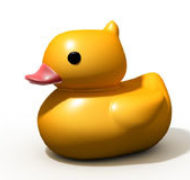An Ocean Epic for a Plastic Age: Book Review
Blog / Produced by The High Calling
If I had to, I could probably count the number of times I’ve seen the ocean on one hand… Four. Throw in the Gulf of Mexico and I might need to use two hands. The ocean doesn’t have a pressing daily reality for me, despite it occupying the majority of the earth’s surface, and with water increasingly becoming a contested resource. And even for folks who might dwell daily beside it, it seems difficult to image the scale of the ocean, or of the complicated web of causes and effects – economic, political, environmental – that make water a pressing issue. And so the question: how to make something as large and complex as the ocean fathomable? Even more, how to make it a thing for which we can feel affection?
Art, I think, can do such a thing. By drawing upon as many layers of complexity and detail and signification as possible, and crystallizing these into a single image, art can make particulars stand in for and relate to the whole. Although I tend to think most often in terms of visual arts, literature, of course, does this as well. Donovan Hohn’s Moby-Duck: The True Story of 28,800 Bath Toys Lost at Sea and of the Beachcombers, Oceanographers, Environmentalists, and Fools, Including the Author, Who Went in Search of Them, reads as such a work. Although a long journalistic essay at heart, Moby-Duck’s elaborate and beautiful narrative, well-developed characters, and attention to the details that make any particular place what it is, turn this book into a delightful read.
Hohn crafts this ocean-spanning story around a rather unassuming premise: the story of a spilled shipping container in the North Pacific which released 28,800 plastic bath toys – 7,200 each of green frogs, blue turtles, red beavers, and yellow ducks – and then commences to create a means by which to comprehend pollution in the oceans, currents, shipping routes and global trade, climate change, the proliferation of plastics, and childhood. And Hohn’s writing makes Moby-Duck a lovely work to read; consider a passage:
Two hundred feet above us the helicopter pilot, Drew Rose, began slowly,
artfully, to ascend. The cable grew taut. The plastic of the Super Sacks
crackled and stretched. The rainwater that had the previous night puddled
into their folds gushed off. Then came the oddly beautiful moment of
levitation, when this bulging, cumbersome bouquet of derelict flotsam,
still dripping rain, spinning and swaying a little, took improbably to the
air, snapping a few spruce branches as it went, and vanished into the blue
asterisk of sky (141).
To explain, Hohn is on Gore Point, in Alaska, with Chris Pallister (“His dark brown hair was cut, monkishly, in a straight line across his forehead as if with the aid of a carpenter’s level. He had a crooked smile, the left corner of his mouth sagging so that he seemed to be scowling even when he wasn’t. The chrome frames of his glasses looked difficult to break”) and company, the Gulf of Alaska Keeper, bagging, airlifting, and shipping off loads of garbage which accumulate along the Alaska coast, plastic bath toys included. The image of those dunes of trash – like much of Moby-Duck – is a terrible reality to consider, and yet Hohn’s gift is to weave such a story so as to be remarkably beautiful; ultimately this may be how we are able to feel empathy and be moved (remember, no distinction between the mental and material) by the work.
Hohn relates infamous photographs of dead albatrosses, enormous piles of non-degradable plastics spilling from their guts, photographs almost too repulsive to look at. But what Hohn does in Moby-Duck is more subtle than this, much like photographer Yao Lu’s New Landscapes Part 1.
These are strikingly beautiful mysterious images, and as the reality of the mountains of garbage sets in, they remain beautiful, but almost terrifyingly so – it is an ugly reality, but one we must see.
As the voyage continues, and the elusive solitary duck fails to emerge cresting over the waves, and the reality of degraded fragments of plastics becomes more apparent, Hohn makes an important distinction:
No one – not Charles Moore, not Chris Pallister, not Greenpeace – will tell you that plastic pollution is the greatest environmental threat our oceans face. Depending on whom you ask, that honor goes to global warming, or ocean acidification, or overfishing, or agricultural runoff. In a way, plastic’s greatest threat may be symbolic, which is not to say that it is empty or cosmetic. Most pollutants are invisible. Saturated with CO2, our oceans have begun to acidify, our scientists tell us – you can discern pH levels with the human eye. But unlike many pollutants (mercury, for instance, or CO2), there is no natural source of plastics and therefore no doubt about how to apportion blame. We’re to blame. Where plastics travel, other, invisible pollutants – pesticides and fertilizers from lawns and farms, petrochemicals from roads, sewage tainted with pharmaceuticals – usually follow. There is no such thing as natural plastic, and because it is so visible, it provides a meaningful – and alarming – bellwether of our impact on the earth. Then, too, as numerous conservationists have told me, compared with other environmental problems this one should be easy to solve. And yet we show no sign of solving it (185-6).
This quantity of plastic floating through our oceans and water systems tells us visually about ourselves: all of this plastic, which might degrade in 500 years, cute plastic ducks included, can be traced right back to a wasteful, throwaway consumer culture. When the Deepwater Horizon rig blew, and live ROV video was broadcast of the crude oil geyser, it seemed a similar situation: not the largest environmental threat in the ocean, but a visible image of an oil-addicted economy. Hohn writes: “What’s most nefarious about plastic, however, is the way it invites fantasy, the way it pretends to deny the laws of matter, as if something – any thing – could be made from nothing; the way it is intended to be thrown away but chemically engineered to last. By offering the false promise of disposability, of consumption without cost, it has helped create a culture of wasteful make-believe, an economy of forgetting” (189). Or, quoting Modern Plastics in the 50s, “The future of plastics is in the garbage can” (227).
This story – of cheap, disposable, global culture – leads Hohn to many significant locales: the Great Pacific Garbage Patch; South Point, Hawaii, where, much like Gore Point, Alaska, mountains of garbage wash ashore; the Artic Circle, where, conceivably some plastic Floatee animals could have escaped to; and Gungzhou, China, where the Floatees were originally manufactured. Likewise we’re introduced to even more people involved in beachcombing, scientific research in the oceans, and the toy and plastics industry. There’s Curtis Ebbesmeyer, publisher of Beachcombers’ Alert! magazine; Charles Moore, leading a crew in the South Pacific combing for plastic; Amy Bower, a scientist at the Woods Hole Oceanographic Institution, leading a team of scientists up to the Labrador Sea; Tony Chan, whose father built the mold for the yellow duck Floatee.
All of these places and people are wonderfully rendered in the circuitous, delightfully told Moby-Duck. The ocean becomes a subject of affection, brought home now by every plastic object I come across. Hohn has written an ocean epic for a plastic age, and takes us along for the ride.
This book review is a reprint courtesy of our friends at The Englewood Review of Books. The Englewood Review of Books is based out of Englewood Christian Church in Indianapolis and publishes reviews for a socially-engaged Christian audience in two formats: a free online edition (weekly) and a print edition (quarterly). Their hope is to get people reading and discussing books in their church communities, reflecting on how we're called into God's work of reconciling all creation.
Image sourced via Microsoft Online. Used with permission. Post by Brent Aldrich.
Don't forget: We'll be starting our next book club on July 18th--enjoying the slow summer days with a journey through Luci Shaw's Breath for the Bones: Art, Imagination and Spirit: A Reflection on Creativity and Faith. To kick off the new reading, you are invited to a Twitter poetry party with Luci on Thursday, July 7th from 9-10 p.m. EST. I hope you will join us!





